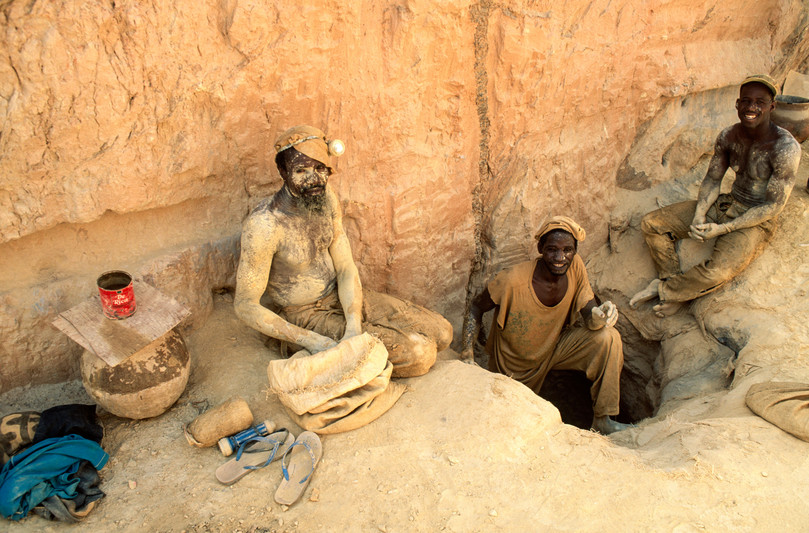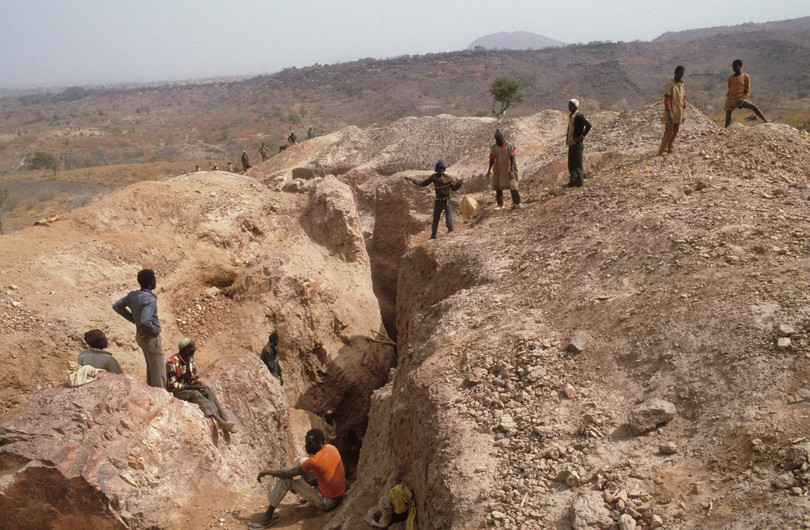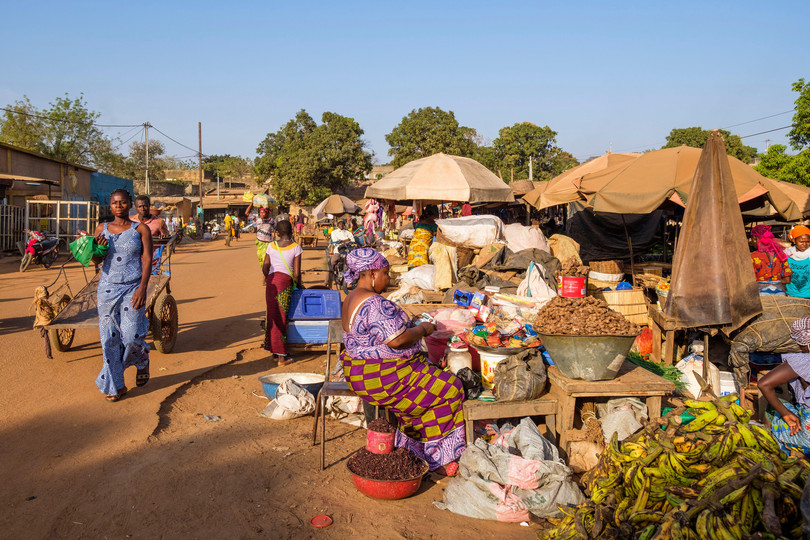Burkina Faso’s Sud-Ouest region risks becoming new zone of insecurity.
Burkina Faso’s Sud-Ouest region, which borders Côte d’Ivoire and Ghana, is home to well-established cross-border smuggling and contraband economies, including of inputs needed for mining production (such as chemicals, explosives, and fuel).1 In recent years, there has been a marked increase in armed criminality and intercommunal violence in the region driven by several factors, including economic hardship, food insecurity and competition over land and water resources.2
Interviews carried out by the GI-TOC with a range of actors in Burkina Faso, Mali, Côte d’Ivoire and Ghana indicate that these new drivers of insecurity pose a serious risk to stability in Sud-Ouest, as well as neighbouring parts of Côte d’Ivoire and Ghana.3 Jihadist groups are increasingly operating in Sud-Ouest, although they have not yet been reported to have become involved in the lucrative gold mining sector in Sud-Ouest.4

Artisanal gold mine workers in Essakane, Burkina Faso.
Alamy
A gold-fuelled economy
Burkina Faso has experienced a rapid transition from a country largely dependent on agriculture to one that now heavily relies on the mining industry. An estimated 14% of Burkina Faso’s GDP and 75% of exports comes from mining, with gold constituting 93% of these exports.5 Gold mining is a major source of livelihood for an estimated 700 000 people in the informal sector (13 times more than those who have formal employment), with 2 million more people engaged in support services in the mining sector.6
The Sud-Ouest region was one of the first gold mining areas of Burkina Faso, dating back to well before the colonial era,7 and plays a major role in the country’s gold production. A 2017 investigation by Burkina Faso’s National Institute of Statistics and Demography reported that the region was responsible for half of the 9.5 tonnes of gold produced at artisanal sites throughout the country, employing 46 086 people across 61 sites in 2016.8 Interviews carried out with local researchers and government officials suggested that there are at least 70 artisanal sites in the region as of September 2021.9
By far the most ASGM activity in Burkina Faso is informal, including in the Sud-Ouest region, with only limited opportunities for miners to become formalized and to achieve more than a subsistence level of livelihood.10 The artisanal mining sector plays a complicated role in Burkina Faso, providing employment and economic activities beyond agriculture, while at the same time contributing to negative environmental and social impacts. A May 2017 study, for example, found that areas with gold extraction sites have better average living standards than their counterparts, but can also see increases in inequality and child labour.11
ASGM in Sud-Ouest has had significant social and environmental impacts, has spurred technological change in both local mining and farming techniques, and provided economic and political opportunities for local actors, often within the context of existing formal and informal institutions and power relations.12 The vast majority of those living in the area rely on subsistence farming. But agricultural activities only occur during the wet season, which is only from May to mid-October. Also, climate change, primarily decreases in rainfall, is making conditions harsher and agriculture increasingly difficult, which makes alternative economic opportunities in the gold sector all the more appealing.13

Gold mining in Yatenga Province, Burkina Faso.
© Universal Images Group via Getty Images
Gold intersects with regional contraband economies
There are robust cross-border smuggling routes and networks in the region. Licit goods such as fuel, motorbikes, electronics and food consumables are smuggled from Ghana and Côte d’Ivoire into south-eastern Burkina Faso for both domestic markets as well as for onward transport to Mali.14 Narcotics, such as cannabis flower grown in Ghana and to a lesser extent northern Côte d’Ivoire, are also trafficked along these routes.15 Black market and counterfeit pharmaceutical products shipped into coastal West African states are also smuggled into Burkina Faso along well-established smuggling itineraries, targeting both domestic markets as well as for onward transport to Mali.16
Artisanal gold mining (ASGM) in the border areas of the Sud-Ouest region intersects with several of these smuggling economies. During the political crisis in 2010–2011, for example, rebel groups in northern Côte d’Ivoire established a smuggling network linking north‑east Ghana to the Sud-Ouest region of Burkina Faso via north-west Côte d’Ivoire.
The intersection of gold mining with criminal networks is perhaps most clear in the smuggling economies that have emerged around the material used for gold mining. The presence of gold in Sud-Ouest Burkina Faso, for example, as well as a proliferation of artisanal mines in the Kayes and Sikasso regions of Mali, has led to an increase in mercury and cyanide trafficking from Ghana into Sud-Ouest, as explored elsewhere in this Risk Bulletin. While mercury was once the most widely used product at the last step of the production chain, in recent years cyanide has become the preferred alternative for extracting gold from residual ‘mud’ and soil in gold-mining areas.17 Cyanide sourced in either Côte d’Ivoire or Ghana enters the Sud-Ouest region via routes linking Bouna to Doropo in Côte d’Ivoire, from where it is smuggled across to Kampti and on to the city of Gaoua, which serves as a major hub and consolidation point for the warehousing and sale of gold-related products smuggled into Sud-Ouest.18 In addition, the import of cyanide-processing technology in northern Ghana is reported to be dominated by Burkinabè, with individuals using cyanide referred to as ‘Burkina Burkina’.19

Figure 7 Key smuggling routes into the Sud-Ouest region, Burkina Faso.
In the north of Ghana, fertilizer subsidised by the Ghanaian government is resold in Ghana and Burkina Faso and reportedly used in the artisanal mines as improvised explosives. A ban on the use of explosives within the ASGM sector in Burkina Faso leaves artisanal miners with very few legal resources when faced with opening up or expanding a pit for hard rock mining, driving demand for illicit explosives.20
There are also reports of gold buyers from Burkina Faso and Côte d’Ivoire buying gold in Upper West Ghana and smuggling it out to their respective countries, as well as Burkinabè coming to Ghana and mining illegally.
The wealth generated by gold mining and gold’s easy transportability can make communities around mines less secure, as well as lure armed actors seeking to engage in mining, banditry or protection economies.21 Weapons are trafficked into southern Burkina Faso, serving a market that includes criminal groups, local ‘self-defence’ groups and miners themselves.22 Weapons in Sud-Ouest region are primarily sourced from Ghana and Côte d’Ivoire as well as domestically.23 Gold mining sites in Sud-Ouest are also consumer markets for black market and counterfeit pharmaceuticals trafficked from Côte d’Ivoire and Ghana, particularly painkillers – including opioids and non-steroidal anti-inflammatory drugs – as well as malaria medications.24
A potential hotspot in need of nuanced approaches
In northern and eastern Burkina Faso, jihadist groups have become directly involved in the gold mining sector, controlling access to some mining areas and collecting percentages of gold revenues.25 Gold mining areas have also been zones of intercommunal conflict involving government-backed self-defence militias and jihadist groups.26
Yet in the Sud-Ouest region, there are no clear or currently defined direct relationships between mineral extraction and jihadist groups.
The Sud-Ouest and neighbouring Cascades regions have, however, seen an increase in violent extremism, intercommunal violence and armed criminality since late 2018.27 In both regions, jihadist groups have carried out multiple attacks on military and civilian targets in 2021, with local officials warning that they are at risk of being overrun.28 Government sources in Burkina Faso told the GI-TOC that Katibat Macina and Ansarul Islam have sleeper cells in the region, which operate across the borders with Côte d’Ivoire and Ghana.29

A market in Gaoua, Sud-Ouest region.
Photo: Alamy
Jihadist groups have made particularly significant inroads on the Ivoirian side of the border, inserting themselves within local criminal economies, particularly in the areas near Comoé National Park (see the map), and carrying out attacks on government forces.30 While the park is host to a wide range of flora and fauna, it is also known to possess significant gold reserves. A local NGO explained that the park is also host to many youths from the surrounding areas who are searching for gold, and that buses of artisanal miners were arriving from Burkina Faso to work on these sites.31
Similar dynamics may be at work on the Ghanaian side of the border, with security threats reported in the north of the country. For example, on 15 June, police forces in the Upper East region were placed on high alert following intelligence of a planned terror attack in the Bolgatanga region, which was highly publicised on social media.32
Given these local and regional dynamics, the Sud-Ouest region of Burkina Faso is an area that warrants serious attention for local, national and international stabilization efforts. Local government officials are already sounding the alarm amid deadly clashes between local communities and miners coming to Sud-Ouest in search of gold.33
At the same time, policymakers should be careful not to prematurely impose ‘conflict mineral’ narratives, which assume a ‘natural’ link between violence, insecurity and ASGM,34 and often lead to interventions that fail to reduce conflict or meet the needs of local populations.35 Instead, policymakers should seek to improve local security and act now to put in place conflict de-escalation and resolution mechanisms in order to make communities more resilient to violent extremism.
Notes
-
Roberto Sollazzo and Matthias Nowak, Tri-border transit: Trafficking and smuggling in the Burkina Faso–Côte d’Ivoire–Mail Region, Small Arms Survey, Briefing Paper, October 2020, https://www.smallarmssurvey.org/resource/tri-border-transit-trafficking-and-smuggling-burkina-faso-cote-divoire-mali-region; North of the countries of the Gulf of Guinea: The new frontier for jihadist groups?, Promediation, Konrad Adenaur Siftung, July 2021. ↩
-
Insecurity in Southwestern Burkina Faso in the context of an expanding insurgency, ACLED, 17 January 2019, https://reliefweb.int/report/burkina-faso/insecurity-southwestern-burkina-faso-context-expanding-insurgency; Observatory of Illicit Economies In West Africa, Northern Côte d’Ivoire: new jihadist threats, old criminal networks, Risk Bulletin – Issue 1, GI-TOC, September 2021, https://globalinitiative.net/analysis/weaobs-risk-bulletin-1/; North of the countries of the Gulf of Guinea: The new frontier for jihadist groups?, Promediation, Konrad Adenauer Siftung, July 2021; Ivory Coast creates northern military zone after deadly attack, Al Jazeera, 14 July 2020, https://www.aljazeera.com/news/2020/7/14/ivory-coast-creates-northern-military-zone-after-deadly-attack. ↩
-
Interviews with researchers and key stakeholders in Mali, Burkina Faso, Ghana, Côte d’Ivoire, July–October 2021. ↩
-
Sam Mednick, Jihadis expand control to new Burkina Faso fronts, Associated Press, 17 July 2021, https://apnews.com/article/africa-religion-government-and-politics-burkina-faso-ab3cc33ca48741adc0d5b33004604b8f; Observatory of Illicit Economies In West Africa, Northern Côte d’Ivoire: new jihadist threats, old criminal networks, Risk Bulletin – Issue 1, Global Initiative Against Transnational Organized Crime, September 2021, https://globalinitiative.net/analysis/weaobs-risk-bulletin-1/; North of the Countries of the Gulf of Guinea: The new frontier for jihadist groups?, Promediation, Konrad Adenauer Siftung, July 2021; Insecurity in Southwestern Burkina Faso in the Context of an Expanding Insurgency, ACLED, 17 January 2019, https://reliefweb.int/report/burkina-faso/insecurity-southwestern-burkina-faso-context-expanding-insurgency; Ivory Coast creates northern military zone after deadly attack, Al Jazeera, 14 July 2020, https://www.aljazeera.com/news/2020/7/14/ivory-coast-creates-northern-military-zone-after-deadly-attack. ↩
-
Cristiano Lanzano, Sabine Luning and Alizèta Ouédraogo, Insecurity in Burkina Faso – beyond conflict minerals: The Complex links between Artisanal Gold Mining and Violence, NAI Politics Notes, 3, 2021. ↩
-
Ibid. ↩
-
Jean Baptiste Kiéthéga, L’or de la Volta noire: Archéologie et histoire de l’exploitation traditionnelle, region de Poura, Haute-Volta. Paris: Editions Karthala, Centre de recherches africaines, 1983. ↩
-
Enquête nationale sur le secteur de l’orpaillage (ENSO), Institut National de la Statistique et de la Démographie, October 2017. ↩
-
Interviews in Burkina Faso, September 2021. ↩
-
Eve Sanou and Tegan Holmes, ‘Scaling Up Gold Trade in Burkina Faso with Eve Sanou’, Artisanal Gold Council, 2 August 2021, https://www.artisanalgold.org/2021/08/scaling-up-gold-trade-in-burkina-faso-with-eve-sanou/. ↩
-
Agnès Zabsonré, Maxime Agbo, Juste Somé, Irène Haffin, Bold exploitation and socioeconomic outcomes: The case of Burkina Faso, Partnership for Economic Policy Working Paper No. 2017-13, 1 March 2017. ↩
-
Cristiano Lanzano and Luigi Arnadli di Balme, Who owns the mud? Valuable leftovers, sociotechnical innovation and changing relations of production in artisianal gold mining (Burking Faso), Journal of Agrarian Change, 15 February 2021, https://onlinelibrary.wiley.com/doi/full/10.1111/joac.12412. ↩
-
Fritz Brugger and Jessica Zanetti, ‘In my village, everyone uses the tractor’: Gold mining, agriculture and social transformation in rural Burkina, The Extractive Industries and Society 7(3), June 2020; McKinsey Global Institute, How will African farmers adjust to changing patterns of precipitation?, May 2020, https://www.mckinsey.com/~/media/mckinsey/business functions/sustainability/our insights/how will african farmers adjust to changing patterns of precipitation/mgi-how-will-african-farmers-adjust-to-changing-patterns-of-precipitation.pdf; Felix Op de Hipt, Bernd Diekkrüger, Gero Steup, Yacouba Yira, Thomas Hoffmann and MichaelRode, ‘Modeling the impact of cimate change on water resources and soil erosion in tropical catchment in Burkina Faso West Africa’, CATENA, Vol 163, April 2018. ↩
-
Interviews with local researchers and journalists in Burkina Faso and Mali, September 2021. ↩
-
Ibid. ↩
-
Interviews with local researchers and journalists in Burkina Faso and Mali, September–October 2021. ↩
-
Interviews with local researchers and actors involved in gold-mining in Mali and Burkina Faso, September-October 2021. See also Cristiano Lanzano and Luigi Arnaldi di Balme, Who owns the mud? Valuable leftovers, sociotechnical innovation and changing relations of production in artisanal gold mining (Burking Faso), Journal of Agrarian Change, 21, 3. ↩
-
Interviews with local journalists and researchers, as well as a former high-level security official in Burkina Faso, September 2021. ↩
-
Interviews in Accra, September 2021. ↩
-
Sadraki Yabre and Tegan Holmes, Is ASGM legal in Burkina Faso? Workshops provide clarity and recommendations for the country’s legal framework, Planet Gold, 29 July 2021, https://www.planetgold.org/asgm-legal-burkina-faso-workshops-provide-clarity-and-recommendations-countrys-legal-framework. ↩
-
Roberto Sollazzo and Matthias Nowak, Tri-border transit: Trafficking and smuggling in the Burkina Faso–Côte d’Ivoire–Mali Region, Briefing Paper, Small Arms Survey, October 2020, https://www.smallarmssurvey.org/resource/tri-border-transit-trafficking-and-smuggling-burkina-faso-cote-divoire-mali-region; Dollar Power, a Ghanaian border town close to Bole, also appears to have experienced these dynamics, with reports of Ivorian rebels increasingly present in the town due to expanding gold mining activity. Bole Chiefs & Residents Angry Over Dollar Power Documentary, News Ghana, 8 February 2017, https://newsghana.com.gh/bole-chiefs-residents-angry-over-dollar-power-documentary/. ↩
-
Roberto Sollazzo and Matthias Nowak, Tri-border transit: Trafficking and smuggling in the Burkina Faso–Côte d’Ivoire–Mali Region, Briefing Paper, Small Arms Survey, October 2020, https://www.smallarmssurvey.org/resource/tri-border-transit-trafficking-and-smuggling-burkina-faso-cote-divoire-mali-region. ↩
-
Interviews in Burkina Faso, Côte d’Ivoire and Ghana, July–October 2021. See also: Roberto Sollazzo and Matthias Nowak, Tri-border transit: Trafficking and smuggling in the Burkina Faso–Côte d’Ivoire–Mali Region, Briefing Paper, Small Arms Survey, October 2020, https://www.smallarmssurvey.org/resource/tri-border-transit-trafficking-and-smuggling-burkina-faso-cote-divoire-mali-region. ↩
-
Interviews with local researchers and journalists in Burkina Faso, September 2021. ↩
-
David Lewis and Ryan McNeill, How jihadists struck gold in Africa’s Sahel, Reuters, 22 November 2019, https://www.reuters.com/investigates/special-report/gold-africa-islamists/; Getting a Grip on Central Sahel’s Gold Rush, International Crisis Group, 13 November 2019, https://www.crisisgroup.org/africa/sahel/burkina-faso/282-reprendre-en-main-la-ruee-vers-lor-au-sahel-central; Nadoun Coulibaly, Islamic State, GSIM, al-Qaeda: The jihadist gold rush in Burkina Faso, The Africa Report, 24 August 2021, https://www.theafricareport.com/120283/islamic-state-gsim-al-qaeda-the-jihadist-gold-rush-in-burkina-faso/; Neil Munshi, Instability in the Sahel: how a jihadi gold rush is fuelling violence in Africa, Financial Times, 26 June 2021. ↩
-
Observatory of Illicit Economies In West Africa, Criminal economies are a key factor in Burkina Faso’s Solhan massacre, Risk Bulletin – Issue 1, Global Initiative Against Transnational Organized Crime, 2 September 2021, https://globalinitiative.net/analysis/weaobs-risk-bulletin-1/; Getting a Grip on Central Sahel’s Gold Rush, International Crisis Group, 13 November 2019, https://www.crisisgroup.org/africa/sahel/burkina-faso/282-reprendre-en-main-la-ruee-vers-lor-au-sahel-central. ↩
-
Insecurity in Southwestern Burkina Faso in the context of an expanding insurgency, ACLED, 17 January 2019, https://reliefweb.int/report/burkina-faso/insecurity-southwestern-burkina-faso-context-expanding-insurgency; Three Burkina troops killed in attack near Ivorian border, Agence France Presse, 26 October 2021, https://www.barrons.com/amp/news/three-burkina-troops-killed-in-attack-near-ivorian-border-01635265506. ↩
-
Sam Mednick, Jihadis expand control to new Burkina Faso fronts, Associated Press, 17 July 2021, https://apnews.com/article/africa-religion-government-and-politics-burkina-faso-ab3cc33ca48741adc0d5b33004604b8f. ↩
-
Interview with law enforcement official and former security official, Burkina Faso, September 2021. ↩
-
Observatory of Illicit Economies In West Africa, Northern Côte d’Ivoire: new jihadist threats, old criminal networks, Risk Bulletin – Issue 1, Global Initiative Against Transnational Organized Crime, 2 September 2021, https://globalinitiative.net/analysis/weaobs-risk-bulletin-1/; North of the Countries of the Gulf of Guinea: The new frontier for jihadist groups?, Promediation, Konrad Adenauer Siftung, July 2021; Ivory Coast creates northern military zone after deadly attack, Al Jazeera, 14 July 2020, https://www.aljazeera.com/news/2020/7/14/ivory-coast-creates-northern-military-zone-after-deadly-attack. ↩
-
Interview with civil society actors, Abidjan, October 2021. ↩
-
Police on high alert after hint of terrorist attacks in Bolga, Tamale, Ghana Web, 15 June 2021, https://www.ghanaweb.com/GhanaHomePage/NewsArchive/Police-on-high-alert-after-hint-of-terrorist-attacks-in-Bolga-Tamale-1287172. ↩
-
Joseph Haro, Conflits orpailleurs-autochtone au Sud-Ouest: l’or, le métal de la discorde, Sidwaya, 9 September 2021, https://netafrique.net/conflits-orpailleurs-autochtones-au-sud-ouest-lor-le-metal-de-la-discorde/. ↩
-
Cristiano Lanzano, Sabine Luning and Alizèta Ouédraogo, Insecurity in Burkina Faso – beyond conflict minerals: The complex links between artisanal gold mining and violence, NAI Politics Notes, 3, 2021. ↩
-
Josaphat Musamba and Christoph Vogel, The problem with ‘Conflict Minerals’, Dissent, 21 October 2021 https://www.dissentmagazine.org/online_articles/the-problem-with-conflict-minerals. ↩
